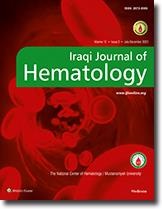Abstract
Abstract:
Plasma cell leukemia (PCL) is a rare and aggressive variant of plasma cell dyscrasias that can occur
either de novo (primary) or as a leukemic transformation of end‑stage multiple myeloma (MM). PCL is
known with a poor prognosis and with a different biologic background, clinical, and laboratory features.
Primary PCL presents more often with extramedullary involvement, anemia, thrombocytopenia,
hypercalcemia, elevated serum 2‑microglobulin, and lactate dehydrogenase levels, in addition to
impaired renal function in comparison with MM. Here, we report a case of a young female who was
admitted with excessive thirst, polyuria, lower backache, fever, and weight loss over 2 months.
Peripheral blood smear showed numerous atypical looking plasma cells, and immunophenotyping on
bone marrow (BM) aspirate demonstrated the presence of clonal plasma cells. She was admitted to
adult hematology ward in Hiwa Hemato‑Oncology Hospital, Sulaimani, Kurdistan, Iraq and received
four cycles of bortezomib, thalidomide, and dexamethasone chemotherapy, followed by two more
cycles of dexamethasone, cyclophosphamide, etoposide, and cisplatin, and later, she proceeded to
autologous BM transplantation. More details of the case are presented below.
Plasma cell leukemia (PCL) is a rare and aggressive variant of plasma cell dyscrasias that can occur
either de novo (primary) or as a leukemic transformation of end‑stage multiple myeloma (MM). PCL is
known with a poor prognosis and with a different biologic background, clinical, and laboratory features.
Primary PCL presents more often with extramedullary involvement, anemia, thrombocytopenia,
hypercalcemia, elevated serum 2‑microglobulin, and lactate dehydrogenase levels, in addition to
impaired renal function in comparison with MM. Here, we report a case of a young female who was
admitted with excessive thirst, polyuria, lower backache, fever, and weight loss over 2 months.
Peripheral blood smear showed numerous atypical looking plasma cells, and immunophenotyping on
bone marrow (BM) aspirate demonstrated the presence of clonal plasma cells. She was admitted to
adult hematology ward in Hiwa Hemato‑Oncology Hospital, Sulaimani, Kurdistan, Iraq and received
four cycles of bortezomib, thalidomide, and dexamethasone chemotherapy, followed by two more
cycles of dexamethasone, cyclophosphamide, etoposide, and cisplatin, and later, she proceeded to
autologous BM transplantation. More details of the case are presented below.
Keywords
Autologous transplantation
leukocytosis
plasma cell leukemia
